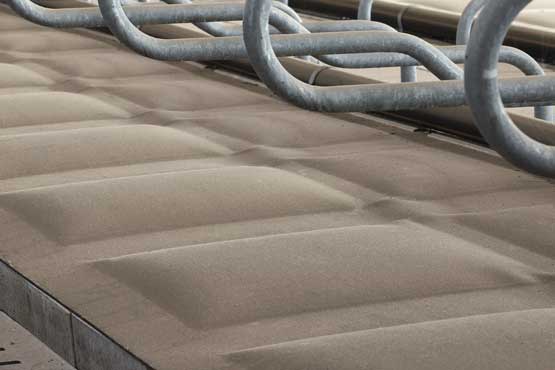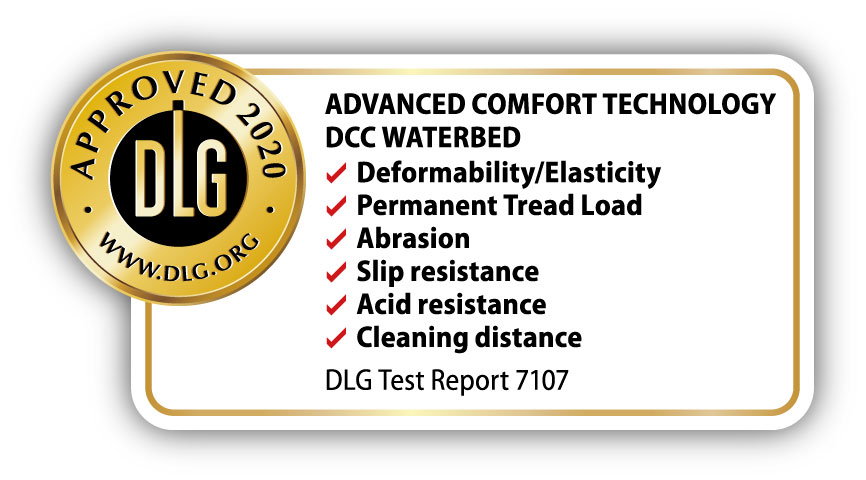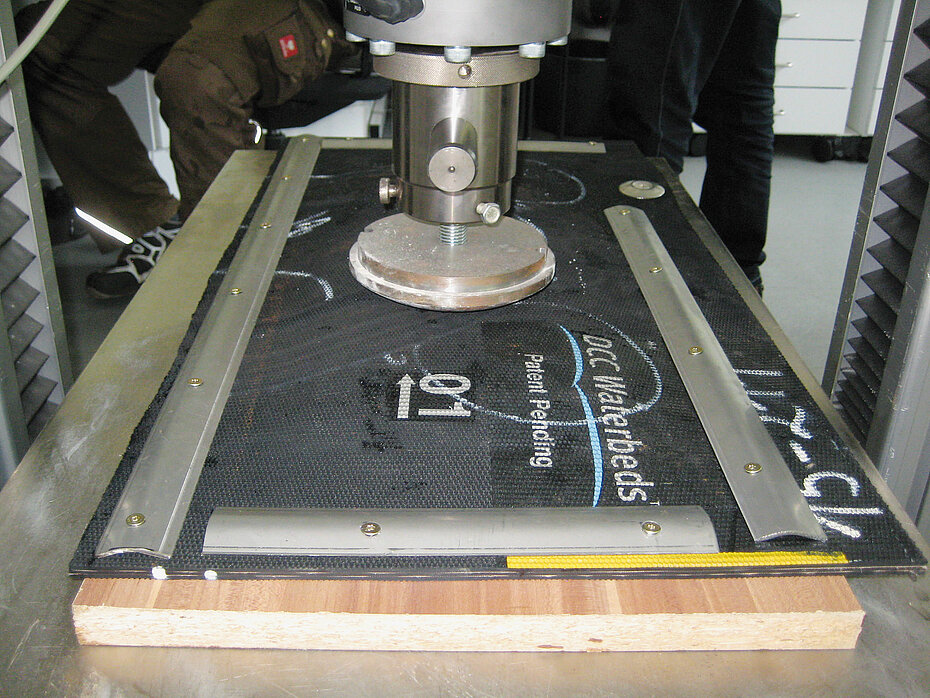Advanced Comfort Technology Inc. DCC Waterbed for Cubicles
DLG-APPROVED “Deformability/Elasticity, Permanent Tread Load, Abrasion, Slip resistance, Acid resistance, Cleaning distance”
The Approval
A test mark „DLG-APPROVED for individual criteria“ is awarded for agricultural products which have successfully fulfilled a scope-reduced usability testing conducted by DLG according to independent and recognised evaluation criteria. The test is intended to highlight particular innovations and key criteria of the test object. The test may contain criteria from the DLG test scope for overall tests, or focus on other value-determining characteristics and properties of the test subject. The minimum requirements, test conditions and procedures as well as the evaluation bases of the test results will be specified in consultation with an expert group of DLG. They correspond to the recognised rules of technology, as well as scientific and agricultural knowledge and requirements. The successful testing is concluded with the publication of a test report, as well as the awarding of the test mark which is valid for five years from the date of awarding.
The DLG Appoved Test “Deformability/Elasticity, Permanent Tread Load, Abrasion, Slip resistance, Acid resistance, Cleaning distance” includes technical measurements on test stands of the DLG Test Center.
The deformability and elasticity, the abrasion resistance, the slip resistance, the acid resistance, the cleaning distance were measured and a permanent tread load was applied. The test was based on the DLG Testing Framework for elastic stable flooring, as of April 2010 and DIN 3763:2020-04 (Elastic floorings for cattle and dairy cows walking and rest surfaces – Requirements and testing). Other criteria were not investigated.
Assessment – Brief Summary
The DCC waterbed tested here, an elastic floor covering for the resting area in cubicle houses, was investigated with regard to durability and comfort properties on test stands in the DLG Focus Test. The deformability and elasticity of the cubicle mat, the abrasion resistance, the slip resistance, the acid resistance, the cleaning resistance were measured and a permanent tread load was applied.
Requirements of DIN 3763 are fulfilled.
Deformation and Elasticity corresponds to class 2 DIN 3763.
Table 1: Assessment in brief
| DLG Quality profile | Evaluation* | |
| Deformability and elasticity in new condition | +++++ | |
| Deformability and elasticity following endurance test | +++++ | |
| Lasting deformation following endurance test | +++++ | |
| Wear following endurance test | ++++ | |
| Abrasion/Wear resistance | ++++ | |
| Resistance to HD cleaner flat jet nozzle | +++ | |
| Resistance to HD cleaner dirt cutters | +++ | |
| Resistance to feed acid mixture | +++ | *** |
| Resistance to uric acid | +++ | *** |
| Resistance to sulfurous acid | +++ | *** |
| Resistance to ammonia | +++ | *** |
| Resistance to barn disinfectants | ++ | *** |
| Resistance to peracetic acid | ++ | *** |
| Slip resistance | ++ | ** |
DLG Evaluation range:
* +++ or better = meets, exceeds or significantly exceeds the established
DLG standards, ++ = meets the legal requirements for marketability,
+= = failed
** Single criteria slip resistance: ++ = passed, + = failed
*** Single criteria acid resistance: +++ = resistant, ++ = = limited resistant, + = failed
The Product
The black DCC waterbed tested here made of rubber is an elastic floor covering in the lying area for high-cubicles.
The barn flooring is available as rolled goods and is reinforced with synthetic fabrics. Surface and bottom: impregnated tissue structure.
During the production process arises between the two layers of the fabric, the individual berth, whereby two chambers per berth arise. The two chambers (waterbed with 120.0 cm width: front chamber approx. 483 mm x 1000 mm, rear chamber approx. 965 mm x 1000 mm) are provided with one filling opening each. Through this openings, for each chamber, the corresponding amount of water (front chamber approx. 15.2 litres, rear chamber approx. 30.3 litres). Close two stainless steel clamps filling openings for the two chambers.
Table 2: Main dimensions and weight
| Length | rolled goods |
| Thickness with water filling | approx. 50 mm |
| Thickness without water filling | approx. 9 mm |
| Weight without water filling | approx. 10.9 kg/m² |
Table 3: Available box width and water filling
| box width | water filling | |
| front chamber | rear chamber | |
| 110.0 cm | approx. 12.30 liter | approx. 24.60 liter |
| 112.5 cm | approx. 13.25 liter | approx. 27.50 liter |
| 115.0 cm | approx. 14.20 liter | approx. 28.40 liter |
| 120.0 cm | approx. 15.20 liter | approx. 30.30 liter |
| 125.0 cm | approx. 15.20 liter | approx. 30.30 liter |
| 130.0 cm | approx. 17.00 liter | approx. 34.00 liter |
The Method
Permanent tread load
The permanent tread load is measured on a test stand with a round steel foot in the standard test programme with 100,000 alternating loads at 10,000 N (corresponding to approx. 1,000 kg). The steel foot is adapted to the natural conditions as an “artificial cow foot”. The foot has a diameter of 105 mm and therefore a contact area of 75 cm²;
the carrying edge of the hoof is simulated by a 5 mm wide ring on the periphery of the sole that projects 1 mm above the rest of the surface.
Abrasion test
In a standardised abrasion test with 10.000 cycles the top cover was grinded with an emery cloth (granulation 280) and a grinding pressure of 500 N (= 8.1 N/cm2 surface pressure). The friction element was cooled continuous with water to prevent an influence of the generated heat during the abrasion test. The size of the grinded area was 61,5 cm².
Slip resistance
The measurements were carried out with the ComfortControl test rig of the DLG test centre.
A loaded (10 kg) round plastic foot (105 mm diameter, with a contact area of 75 cm2, 3 mm wide ring at the periphery of the ground) was pulled with a velocity of 20 mm/s across the mat.
Acid resistance
A permanent dipping test in accordance to DIN EN ISO 175:2000 (performance of synthetic material against liquid chemicals) was carried out. Test samples (size 30 x 30 mm) were completely dipped into different test liquids for 24 hours and 28 days (room temperature 20° Celsius). In the 28 days test the liquids were changed weekly. After the 28 days the samples were washed with distillate water and dried for 24 hours. Before and after the dipping the weight, the dimensions and the shore hardness (shore A) of the test samples were measured.
Additional visual evaluation was done for alterations like colour changing, swelling, destruction or crystallisation. All samples were evaluated in comparison to the standard water.
Cleaning distance
In test stand trials with a high pressure cleaner (approximately 145 bar, exposure period 1 minute with a 25° flat jet nozzle and a coarse dirt remover) the distance was measured where no damage occurs.
The Test Results in Detail
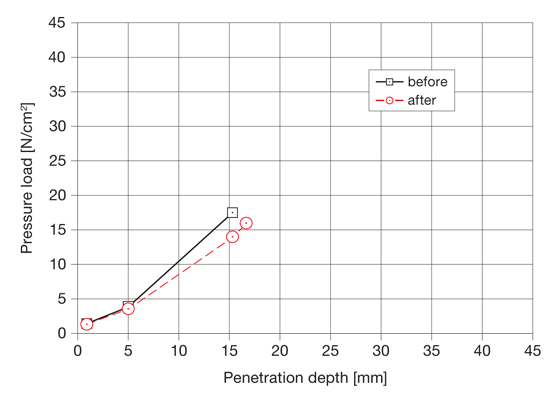
Deformability and elasticity
In the ball penetration tests in new condition with a calotte (r = 120 mm), penetration depth was 15.3 mm. The resulting calculated bearing pressure of 17.3 N/cm² indicates a low load on the carpal joints when lying down and getting up. Elasticity was measured following a permanent tread load exerted by a steel foot (contact area: 75 cm²) with 100,000 alternating loads at 10,000 N. Following the endurance test, the penetration depth of the calotte increased from 15.3 mm to 16.6 mm. The bearing pressure decreased from 17.3 N/cm² to 16.0 N/cm² (see Fig. 3).
This means that deformability and elasticity slightly decrease.
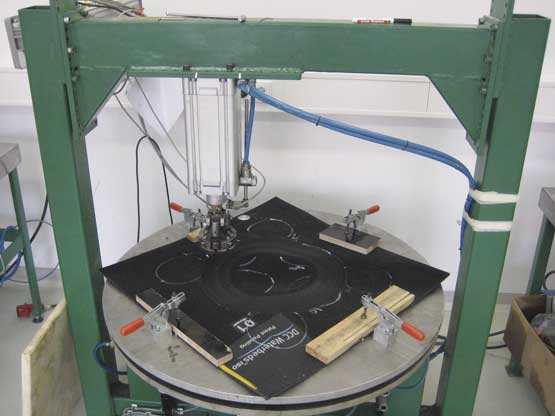
Permanent tread load
No noticeable wear was observed following exposure to permanent tread load on a test stand with 100,000 alternating loads at 10,000 N. No lasting deformation was observed.
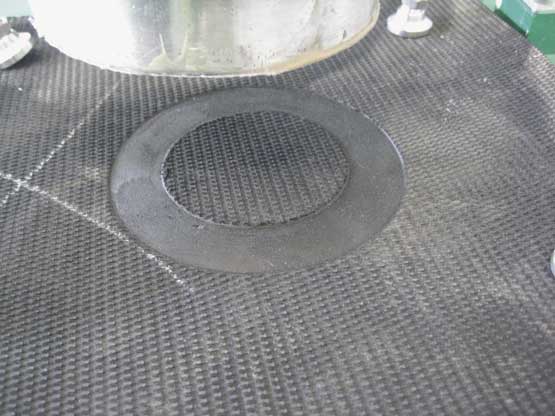
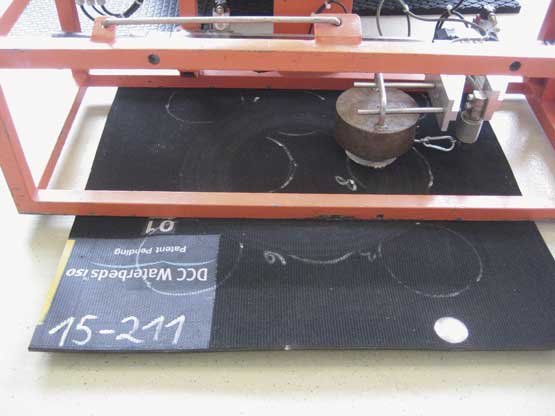
Abrasion test
The abrasion depth after 10,000 cycles amounted to 1.0 mm, this corresponds to approximately 22 % of the rubber thickness.
Of the ground surface 3.5 grams were rubbed off. The abrasion depth and the slight grit implicate a good wear resistance of the water bed.
Slip Resistance
The slide pulling tests showed a good slip resistance on the dry or wet rubber mat surface in new condition. The measured friction coefficients (μ) surpassed the minimal value of μ = 0,40 (DIN 3763) and μ = 0.45 (DLG test program).
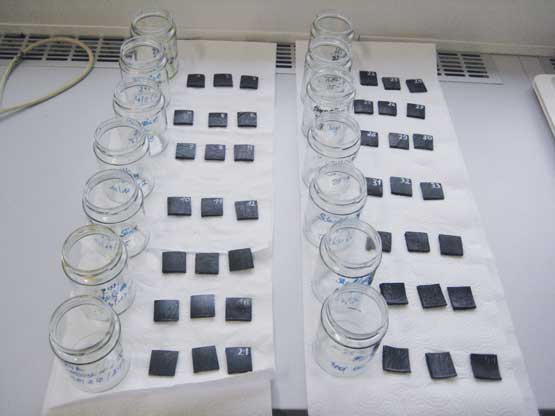
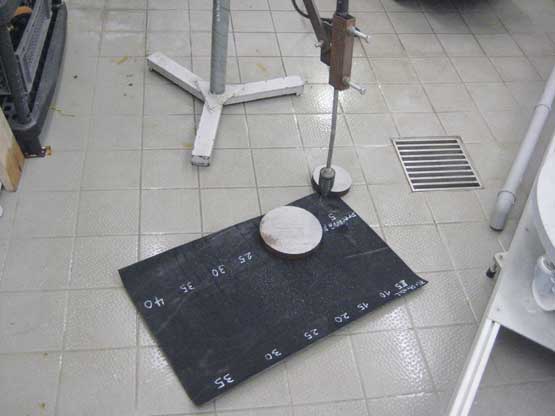
Acid resistance
The rubber mat was resistant against feed acid mixture and excrement acids and limited resistant against barn desinfestion liquid and peracetic acid.
The differences in weight, thickness and Shore A hardness between the acid treated and not acid treated samples were with feed acid mixture and excrement acids minor and lay in the range of water as standard. Against the used liquids the rubber mat seems to be suited for the described use.
Cleaning distance
In test stand trials with a high pressure cleaner damage to the water bed only occurred when a minimum distance of 40 cm (with a coarse dirt remover) and 25 cm (with a flat-jet nozzle) was not kept.
For cleaning and disinfection of the floor cover, only the cleaning agents permitted by the manufacturer should be used.
Table 4: Test liquids and results – acid resistance
| Test liquid | Concentration | Result after 24 hours residence time | Result after 28 days residence time | Evaluation |
|---|---|---|---|---|
| Feed acid mixture | ||||
| concentrate, pH 2 | no changing | no changing | resistant | |
| Excrement acids | ||||
| Uric acid | saturated urea solution (0,4 %) | no changing | no changing | resistant |
| Sulfurous acid | 5-6 % SO2 | no changing | no changing | resistant |
| Ammonia solution | 32 % solution | no changing | no changing | resistant |
| Disinfection liquid | ||||
| Barn Disinfection liquid | 2%-solution of a product with formic acid and glyoxyl acid | no changing | slight bubble formation on the bottom of the mat | limited resistant |
| Peracetic acid | 3000 ppm | colour change | change in material thickness; Shore hardness and weight around 10 - 15 % | limited resistant |
Summary
Based on test-stand investigations, the criteria tested in this DLG Approved Test evaluate the comfort and durability properties of the DCC Waterbed for use in the resting area of high cubicles in cubicle houses.
The tested DCC Waterbed met the requirements of DIN 3763 and the DLG Testing Framework with respect to the investigated criteria.
Applicant and Test implementation
Manufacturer and Applicant
Manufacturer and Applicant
Advanced Comfort Technology Inc.
752 Lois Drive,
Sun Prairie,
WI 53590
North America
Contact:
Telephone 00 608 709 2693
fax 00 608 709 2615
info@advancedcomforttechnology.com
www.dccwaterbeds.com
Distribution
Spinder Dairy Housing Concepts
Zeppelinlaan 3,
9207 JG Drachten,
Niederlande
Telephone 0031 (0)5122 37801
sales@spinder.nl
Further information
Testing agency
DLG TestService GmbH,
Gross-Umstadt location
The tests are conducted on behalf of DLG e.V.
DLG test framework
DLG Testing Framework for elastic stable flooring,
as of April 2010
DIN 3763:2020-04 (Elastic floorings for cattle and dairy cows walking and rest surfaces – Requirements and testing)
Department
Agriculture
Division head
Dr. Michael Eise
Test engineer(s)
Dr. Harald Reubold *
* Author
Contact
DLG TestService GmbH - Groß-Umstadt location • Max-Eyth-Weg 1 64823 Groß-Umstadt Germany • Tel.: +49(0)69 24 788-611 • tech@DLG.org

